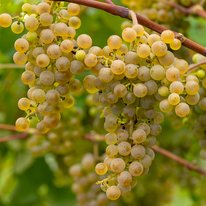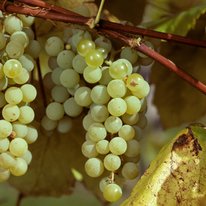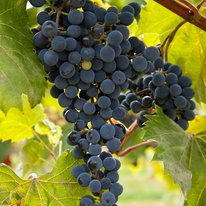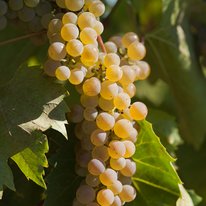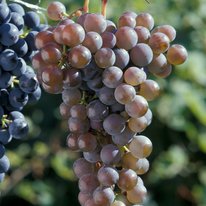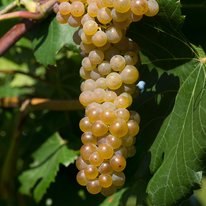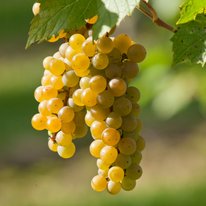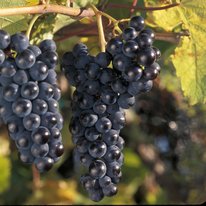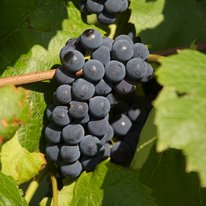The University of Minnesota is recognized as one of the top wine grape research programs in the country, with the goal of developing high-quality, cold-hardy, and disease-resistant wine grape cultivars. The wine grape breeding program began in the mid-’70s, and in 2000 an enology lab and research winery opened at the Horticultural Research Center.
University of Minnesota Wine Grape Varieties
Clarion
- White wine
- Less vigorous growth habit than other cold-hardy varieties
- Wine has flavors of pear, citrus, melon, apricot and chamomile
- Performs well in Zone 5, marginally hardy in Zone 4
- Available in limited quantities spring 2023
Edelweiss*
- Table, wine
- Large-clustered, white-seeded table grape with a wine Concord-like flavor
- May need winter protection
- Introduced in 1977
Frontenac aka Frontenac noir
- Red and rosé, port
- Vigorous and very disease resistant
- Wine has flavors of cherry and plum
- Can be high in acidity
- Introduced in 1996
Frontenac blanc
- White wine
- White-fruited sports of Frontenac and Frontenac gris with earlier harvest date
- Became available in 2012
Frontenac gris
- White wine
- Vigorous and very disease resistant
- Wine has a characteristic peach flavor
- Can be high in acidity
- Introduced in 2003
Itasca
- White wine
- Lower acidity and high sugar levels
- High resistance to downy and powdery mildew and the insect phylloxera
- Introduced in 2017
La Crescent
- White wine
- Very cold hardy
- Aromatic wine has flavors of apricot, citrus, and tropical fruit
- Moderately disease resistant
- Introduced in 2002
Marquette
- Red wine
- Resists downy and powdery mildew, and black rot, with open, orderly growth habit
- Wine has complex notes of cherry, berry, black pepper, and spice on both nose and palate
- Introduced in 2006
University of Minnesota Table Grape Varieties
Bluebell
- Table, juice, jelly
- Early ripening
- Blue-seeded table grape with a juice, jelly mild Concord-like flavor
- Disease resistant
- Introduced in 1944
Swenson Red*
- Table
- Red-seeded table grape with refreshing flavor and crisp texture
- Needs winter protection and a thorough spray program
- Introduced in 1977
*Joint release with Elmer Swenson.
Buy U of M grape vines - USA Licensed Nurseries
Buy U of M grape vines - Canada licensed nurseries
Wine Grapes FAQs
Are these varieties really that cold hardy?
Yes! These are some of the most cold hardy varieties in the world. They've all borne a full crop after temperatures of -30°F or colder. We don't like to give a precise value for exactly how hardy they are because there are so many variables involved. For example, overcropping or poor disease control the previous year will substantially reduce the hardiness of any grapevine. Even when well grown, every winter is different in terms of snow cover and acclimation (or deacclimation) conditions.
Is the wine from these varieties actually good quality or is it just acceptable where few other grapes can be grown?
These varieties really can make excellent wines when well grown and vinified. Minnesota wineries and other wineries have been winning in national and international competitions with wines made from these new varieties. They are also now starting to be planted in mainstream eastern wine regions where growers have many other options to choose from.
How can I learn more about growing grapes in Minnesota?
For home growers and wine enthusiasts:
- University of Minnesota Extension has resources for growing grapes in the home garden.
- Visit the University of Minnesota Landscape Arboretum's Farm at the Arb to see how grapes are grown commercially in northern climates.
- Check out the Minnesota Grape Growers Association and Minnesota Farm Winery Association to learn more about Minnesota vineyards and wineries.
- Visit local wineries like the ones on the Great River Road Wine Trail, Heartland Wine Trail, Upper St. Croix Wine Trail, or Three Rivers Wine Trail.
- Read 'Growing Grapes in Minnesota' a 70 page book from MGGA and the 'Midwest Grape Production Guide'.
- After these steps, plant a few vines and see how they do for you. Growing even half a dozen vines can be very educational and might help you avoid making large-scale mistakes later on.
For commercial growers:
- Take the free online course Growing Grapes in Minnesota: Vineyard Management. Our Grape Breeding and Enology program developed this course specifically about growing cold-hardy grapes in Minnesota.
- Check out the University of Minnesota Commercial Fruit Production website.
- Join the Minnesota Grape Growers Association (MGGA) and attend their annual Cold Climate Grape & Wine Conference in February.
- Read 'Growing Grapes in Minnesota' a 70 page book from MGGA and the 'Midwest Grape Production Guide'.
- Take a U of M course on grapes and wine. Options include Hort 1031 Vines and Wines - An Introduction to Viticulture and Enology as well as a more advanced course on fruit growing, Hort 5031 - Sustainable Viticulture and Fruit Production. Visit the U of M Class Schedule site to check for course availability.
- Plant a few vines and see how they do for you. Growing even half a dozen vines can be very educational and might help you avoid making large-scale mistakes later on.
Where can I see U of M grape varieties?
The University of Minnesota Landscape Arboretum's Farm at the Arb has all U of M grape varieties planted for visitors to see. The grape demonstration plots show how grapes are grown commercially in northern climates and include every University of Minnesota grape variety that has been released. The best time to see the grapes is typically late summer and early fall.
What are the best parts of Minnesota for growing grapes?
Grapes can be grown as a hobby throughout the state, although only very early ripening and cold hardy types should be tried in northern Minnesota. In terms of commercial viticulture, the most promising areas in the state are along the Mississippi, Minnesota, and St. Croix river valleys in the southern third of the state. These valleys were created in glacial times and have large hills surrounding them as well as gravelly or sandy soils well suited for grapes.
Is it legal for me to propagate my own vines from cuttings?
Since Frontenac gris, Itasca, La Crescent, and Marquette are patented varieties they can't be legally propagated without a license from the U of M. Currently, only licensed nurseries can legally propagate these vines. If you are not licensed, please contact one of these nurseries to place your order or purchase a license to propagate U of M grape vines.
Propagation reporting for Frontenac Grapes is managed through cooperation with the Minnesota Nursery Research Corporation (MNRC). Fees of $0.40 per plant are collected to help fund plant breeding efforts at the University of Minnesota, and foster the development of successful new plant introductions. If you propagate these varieties, please support this program by contacting Pat Bailey, MNRC President, at [email protected].
When will the U of M varieties be available in Canada?
Frontenac, Frontenac gris, La Crescent, Itasca and Marquette are currently available from licensed nurseries in Canada.
Are the U of M varieties available in California, Oregon, or Washington?
Yes, plants that meet the clean stock requirements of these states are available from licensed nurseries in those states.
What's the single biggest factor to consider in deciding where to plant a vineyard?
Assuming your property is located somewhere in southern or central Minnesota, the biggest factor to consider is elevation. Plant your vines on high ground with good air drainage to avoid late frosts in the spring and early frosts in the fall. South slopes are ideal but not essential. Avoid north slopes as the reduced sunlight and heat will retard ripening and the crop will have reduced sugar and increased acidity levels.
What kind of training system should I use with U of M varieties?
Our standard practice for test vines at the University of Minnesota is to grow them all on a high cordon (HC) training system in order to reduce the number of variables in our research. Frontenac, Frontenac gris, La Crescent, and Marquette have all performed well when trained to that system. However, that's not to say that they wouldn't also perform as well or better on other training systems.
Frontenac and Frontenac gris have also done well when grown using the Vertical Shoot Positioned (VSP) system, whereas La Crescent appears to be too sprawling for VSP to be the best choice. Marquette is the most upright and least vigorous of the four and therefore the most likely to succeed on VSP, however research shows crop yields are lower on VSP. When choosing between VSP and HC some factors to consider are the potentially better light exposure and fruit quality of VSP as opposed to the reduced labor and greater risk of frost damage from HC. (Since VSP is lower to the ground, vines are more subject to frost damage using that system.) In some areas (Quebec) Frontenac has been grown on very low VSP cordons about a foot off the ground. This system only makes sense for vines that are covered over the winter and since Frontenac is a very winter hardy variety... we do not recommend such low cordons
What should I do for a disease or pest problem?
Home growers can visit the University of Minnesota Extension What's wrong with my plant? site to address pest problems.
Commercial growers can explore Extension resources and check the Minnesota Fruit Research blog. If you can't find the information you're looking for, fill out our contact form.
Can you provide a good "recipe" for winemaking with each cultivar?
Unfortunately, no. While we can provide general guidelines, the effect of different microclimates, viticultural practices, and general terroir makes each lot of grapes very different, and in need of different processing practices. Making the best wine from your grapes requires cautious experimentation, good record keeping, and a good grasp of basic winemaking principles.

